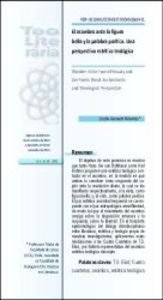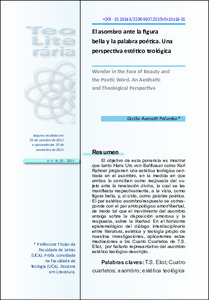Please use this identifier to cite or link to this item:
https://repositorio.uca.edu.ar/handle/123456789/5221| Título: | El asombro ante la figura bella y la palabra poética : una perspectiva estético teológica | Autor: | Avenatti de Palumbo, Cecilia Inés | Otros colaboradores: | Universidad Católica Argentina. Facultad de Filosofía y Letras | Palabras clave: | Balthasar, Hans Urs von, 1905-1988; Rahner, Karl, S.I., 1904-1984; Eliot, T. S., 1888-1965; LITERATURA NORTEAMERICANA; ESTETICA; TEOLOGIA | Fecha de publicación: | 2015 | Editorial: | Pontifícia Universidde Católica de São Paulo ; Associação Latino Americana de Literatura e Teologia (ALALITE) | Cita: | Avenatti de Palumbo, Cecilia. “El asombro ante la figura bella y la palabra poética : una perspectiva estético teológica” [en línea]. Teoliterária 5-10 (2015). Disponible en: https://repositorio.uca.edu.ar/handle/123456789/5221 | Resumen: | Resumen: El objetivo de esta ponencia es mostrar que tanto Hans Urs von Balthasar como Karl Rahner proponen una estética teológica centrada en el asombro, en la medida en que ambos lo conciben como respuesta del sujeto ante la revelación divina, la cual se les manifiesta respectivamente, a la vista, como figura bella, y, al oído, como palabra poética. El par estético asombro/respuesta se corresponde con el par antropológico amor/libertad, de modo tal que el movimiento del asombro arraiga sobre la disposición amorosa y la respuesta, sobre la libertad. En el horizonte epistemológico del diálogo interdisciplinario entre literatura, estética y teología propio de nuestras investigaciones, aplicaremos estas mediaciones a los Cuatro Cuartetos de T.S. Eliot, por hallarlo representativo del asombro estético teológico descripto. Abstract: The objective of this paper is to show that Hans Urs von Balthasar and Karl Rahner propose a theological aesthetics centered in wonder: both of them consider it as a subject’s response to divine revelation, which manifests a beautiful figure to see and a poetic word to hear. The aesthetic pair wonder/answer corresponds with the anthropological pair love/freedom, so that the movement of wonder is rooted in loving disposition and the response in freedom. In the epistemological horizon of interdisciplinary dialogue between literature, aesthetics and theology of our own research, we will apply these mediations to T.S. Eliot´s Four Quartets, by finding it representative of the theological aesthetic wonder described. |
URI: | https://repositorio.uca.edu.ar/handle/123456789/5221 | Disciplina: | LITERATURA | Derechos: | Acceso Abierto | Fuente: | Teoliterária Vol. 5, Nº 10, 2015 |
| Appears in Collections: | Artículos |
Files in This Item:
| File | Description | Size | Format | |
|---|---|---|---|---|
| asombro-figura-bella-palabra-poetica.jpg | 7,71 kB | JPEG |  View/Open | |
| asombro-figura-bella-palabra-poetica.pdf | 444,36 kB | Adobe PDF |  View/Open |
Page view(s)
474
checked on Apr 27, 2024
Download(s)
258
checked on Apr 27, 2024
Google ScholarTM
Check
This item is licensed under a Creative Commons License

